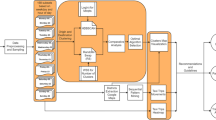Abstract
Due to the rapid growth of wireless communications and positioning technologies, trajectory data have become increasingly popular, posing great challenges to the researchers of data mining and machine learning community. Trajectory data are obtained using GPS devices that capture the position of an object at specific time intervals. These enormous amounts of data necessitates to explore efficient and effective techniques to extract useful information to solve real world problems. Traffic flow pattern mining is one of the challenging issues for many applications. In a literature significant number of approaches are available to cluster the trajectory data, however the clustering has not been explored for trajectories pattern mining in bi-directional road networks. This paper presents a novel technique for excavating heavy traffic flow patterns in bi-directional road network, i.e. identifying divisions of the roads where the traffic flow is very dense. The proposed technique works in two phases: phase I, finds the clusters of trajectory points based on density of trajectory points; phase II, arranges the clusters in sequence based on spatiotemporal values for each route and directions. These sequences represent the traffic flow patterns. All the routes and sections exceeding a user specified minimum traffic threshold are marked as high dense traffic areas. The experiments are performed on synthetic dataset. The proposed algorithm efficiently and accurately finds the dense traffic in bi-directional roads. Proposed clustering method is compared with the standard k-means clustering algorithm for the performance evaluation.









Similar content being viewed by others
References
Agrawal R, Srikant R (1995) Mining sequential patterns. In: Proceedings of 1995 International Conference on Data Engineering (ICDE), pp 3–14
Andrienko N, Andrienko G (2011) Spatial generalization and aggregation of massive movement data. IEEE Trans Vis Comput Graphics 17(2):205–219
Arthur D, Vassilvitskii S (2007) k-means++: the advantages of careful seeding. In: SODA 07 Proceedings of the eighteenth annual ACM-SIAM symposium on discrete algorithms, pp 1027–1035
Buchin M, Driemel A, Kreveld MV (2010) An algorithmic framework for segmenting trajectories based on spatio-temporal criteria. In: Proceeding GIS’10 Proceedings of the 18th SIGSPATIAL International Conference on Advances inGeographic Information Systems, pp 202–211
Cao H, Mamoulis N, Cheung DW (2005) Mining frequent spatiotemporal sequential patterns. In: Proceedings of data mining, p 8289
Chen L, Ozsu MT, Oria V (2005) Robust and fast similarity search for moving object trajectories. In: Proceedings of 2005 ACM SIGMOD International Conference on Management of Data, Baltimore, pp 491–502
Cheng H, Yan X, Han J, Philip S (2008) Direct discriminative pattern mining for effective classification. In: ICDE ’08 Proceedings of the 2008 IEEE 24th International Conference on Data Engineering
Coppi R, D’Urso P (2002) Fuzzy K-means clustering models for triangular fuzzy time trajectories. Stat Methods Appl 11(1):21–40
Coppi R, D’Urso P (2003) Three-way fuzzy clustering models for LR fuzzy time trajectories. Comput Stat Data Anal 43(2):149–177
Coppi R, D’Urso P (2006) Fuzzy unsupervised classification of multivariate time trajectories with the Shannon entropy regularization. Comput Stat Data Anal 50(6):1452–1477
Coppi R, D’Urso P, Giordani P (2010) A fuzzy clustering model for multivariate spatial time series. J Classif 27(1):54–88
D’Urso P, Massari R (2013) Fuzzy clustering of human activity patterns. Fuzzy Sets Syst 215:29–54
D’Urso P (2005) Fuzzy clustering for data time arrays with inlier and outlier time trajectories. IEEE Trans Fuzzy Syst 13(5):583–604
D’Urso P (2004) Fuzzy C-means clustering models for multivariate time-varying data: different approaches. Int J Uncertain Fuzz Knowl Based Syst 12(3):287–326
D’Urso P (2000) Dissimilarity measures for time trajectories. Stat Methods Appl 9(1–3):53–83
Ester M, Kriegel H, Sandar J, Xu X, Kut A (1998) A density-based clustering in spatial databases: the algorithm GDBSCAN and its applications. Data Min Knowl Discovery 2(2):169–194
Gaffney S,Smyth P (1999) Trajectory clustering with mixtures of regression models. In: Proceedings of 5th ACM SIGKDD Internationa Conference on Knowledge Discovery and Data Mining, San Diego, pp 63–72
Giannotti F, Nanni M, Pedreschi D, Pinelli F (2007) Trajectory pattern mining, KDD’07, San Jose, pp 330–339, August 12–15
Gudmundsson J, Laube P, Wolle T (2012) Computational movement analysis. Springer handbook of geographic information, pp 725–741
Kang J, Yong H (2010) Mining spatio temporal pattern in trajectory data. J Info Process Syst 6(4):521–536
Kang J, Yong H (2009) Mining trajectory patterns by incorporating temporal properties. In: Proceedings of the 1st International Conference on Emerging Databases (EDB2009)
Ossama O, Mokhtar HMO, El-Sharkawi ME (2012) Dynamic k-means: a clustering technique for moving object trajectories. Int J Intell Inf Database Syst 6(4):307–327
Wang W, Yang J, Muntz R (1997) STING: a statistical information grid approach to spatial data mining. In: Proceedings of 23rd International Conference on very large databases, Athens, pp 186–195
Zhang T, Ramakrishnan R, Livny M (1996) BIRCH: an efficient data clustering method for very large databases. In: SIGMOD’96
Zhou W, Xiong H, Ge Y, Yu J, Ozdemir H, LeeDirection KC (2010) Clustering for characterizing movement patterns. IEEE IRI 2010, pp. 4–6
Acknowledgments
We thank to the editor and anonymous reviewers for valuable comments that helped us to improve this article.
Author information
Authors and Affiliations
Corresponding author
Rights and permissions
About this article
Cite this article
Mirge, V., Verma, K. & Gupta, S. Dense traffic flow patterns mining in bi-directional road networks using density based trajectory clustering. Adv Data Anal Classif 11, 547–561 (2017). https://doi.org/10.1007/s11634-016-0256-8
Received:
Revised:
Accepted:
Published:
Issue Date:
DOI: https://doi.org/10.1007/s11634-016-0256-8




